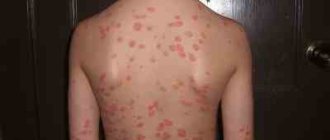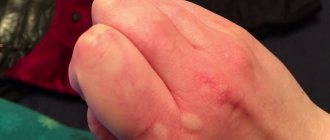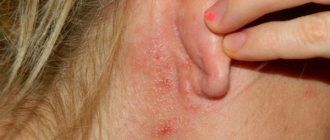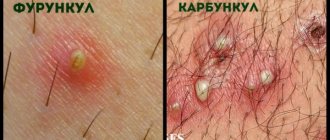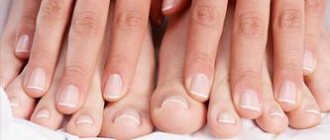Psoriasis is common and refers to skin diseases. People of all ages get sick, with young people especially susceptible to the disease. The pathogen has not been identified. It is not transmitted through contact and is not contagious.
Appears on various parts of the body, and can occur on the scalp. It causes significant discomfort and inconvenience, and spoils the patient’s appearance.
Description of the disease and clinical picture of psoriasis
Psoriasis
Psoriasis has another common name – lichen planus. This is an infectious disease that develops into a chronic stage and is characterized by damage to the skin. Recently, psoriasis has been classified as an autoimmune pathology.
Externally, the disease is manifested by the appearance of red spots on the skin, slightly raised above the surface and having a dry coating. These spots (papules) usually form plaques by clustering in one place. The nature of papules is chronic inflammation and excessive proliferation of epidermal cells.
As cells grow, the affected areas quickly thicken and begin to rise above the surface of healthy skin. The primary stage of the disease is characterized by the formation of pale spots, then the plaques darken to a pink tint.
The risk factor for developing the disease does not depend on gender. Psoriasis affects about 4% of the entire population, and skin plaques are most often observed in adolescents.
The most vulnerable places for psoriasis are areas that experience deformation and pressure. These are, first of all, elbows, knees, feet. Eczema forms on the buttocks, hands, and scalp.
Eczema on top of head
Symptoms of the disease manifest themselves in the form of swelling of the extremities, itching in the areas affected by psoriasis, rash of papules, changes in the structure of the nails and even the fingers and toes.
This was a generalized picture. In a particular case, the symptoms depend on the organism itself and the stage of the disease.
The photo shows lesions in different stages of the disease:
- Initial stage. At the initial stage, psoriasis is expressed by small pimples or even a rash. But in the photo you can see that the disease looks like a common allergic reaction. But after the papules become covered with scales, we can talk about the appearance of the first symptoms of psoriasis.
- Progressive course: second stage. The transition of the disease to a progressive stage is associated with new, more profuse rashes. They form in previously affected areas, but are already accompanied by severe itching. Papules sharply increase in size, which indicates the progress of psoriasis.
Related article:
Diet for psoriasis is the key to successful therapy
- Acute stage. Formations that discovered themselves at earlier stages begin to peel off, simultaneously slowing down their growth. But new papules form in various areas of the skin near mechanical damage. It is considered the most severe stage of psoriasis and requires immediate treatment.
- Stationary picture: stage of stable flow. A picture of the disease that does not change over time is observed in the stationary stage. During the period under review, no new rashes are observed, and the old affected areas of the epidermis disappear in the form of husks.
- Regression: stage of remission. The disease recedes at the regression stage. Psoriatic areas completely disappear along with accompanying symptoms.
Reasons for the development of the disease
There are several reasons that provoke the disease for the formation of psoriatic zones. One of them is enough for psoriasis to begin to manifest itself. To determine psoriasis at home, photos from various sources are usually used, although the picture can be individual.
Knowing all the predisposing factors will help you recognize psoriasis on your own, because in the early stages it is easier to fight it.
Risk factors for developing the disease include:
- Predisposition to psoriasis at the genetic level;
- Nervous overstrain, disruption of the psycho-emotional background;
- Diseases associated with disorders of the endocrine system;
- Metabolism-related diseases;
- The presence of parasites in the body (ascariasis, enterobiasis);
- Viral infection;
One of the popular questions about this disease is the question of how dangerous psoriasis is for others. Despite the abundance of risk factors, the disease is not transmitted from person to person. However, do not forget about heredity.
Causes of psoriasis
Psoriasis can appear in almost any person; there are many possible causes for its occurrence. Doctors and scientists have still not been able to compile a complete and unified list of the reasons for which the disease appears.
The most common consequences of psoriasis are:
- Prolonged stress . Due to constant exposure to nervous situations, a malfunction occurs in the body, which leads to a decrease in the general condition of the body and the human immune system.
- Receipt by inheritance. There is a theory according to which it is possible to inherit the disease if one of the parents also has this disease. The probability of the disease occurring is approximately 50%.
- Severe viral or infectious disease. Having suffered a serious illness can lead to a weakened immune system, which in turn can lead to the appearance of psoriasis.
- Any disease that weakens a person's immune system. Based on the reasons for getting the disease, any disease that lowers the general level of the body’s condition.
- Microtraumas of the upper layer of the skin. One of the likely causes of psoriasis is an unusual reaction of the human body to any external irritants. These also include various skin injuries.
External features of psoriasis on the legs
Psoriasis on the legs
Many dermatologists keep statistics on the disease. They note increasing cases of psoriasis on the legs and arms. Already in the initial stage, skin rashes appear, localized between the fingers, on the feet and legs.
There have been cases of psoriasis affecting the skin on the knees and feet. Studies have shown that these areas are more susceptible to infection due to mechanical stress.
Symptoms of psoriasis do not appear suddenly. At the first stage, the lesions gradually develop with temporary pauses. One can note the wavy nature of the course of the disease.
Practice shows that psoriasis develops very rarely in children.
Depending on the period of damage to the epidermis by psoriasis, the external picture may be different. All formations are characterized by dryness of the damaged area.
Features of the initial stage of the disease
In addition to the pale spots mentioned earlier, red areas with clear boundaries can also be used to determine the disease. This is how psoriasis manifests itself at an early stage of development.
Early stage of psoriasis on the legs
Subsequently, these areas begin to rise above the skin. Over time, itching is added to the picture, which means the disease moves to the next stage.
Related article:
Instructions for treating psoriasis with Naftaderm ointment
The onset of skin lesions on the heels usually occurs in the cold season. Most likely, the determining factor here is not temperature, but vitamin deficiency accompanying the change in season.
Video about the initial stage of psoriasis on the legs
Classification of psoriasis of the lower extremities
On the legs, psoriasis occurs in only 30% of cases of skin lesions. Dermatologists classify the initial stage of development of the disease in this part of the body into two groups:
- Psoriasis type 1. It affects the legs of children, adolescents, adult men and women due to their genetic predisposition to this disease. In total, at least 60% of all patients had relatives who suffered from this disease. Most often, psoriasis of the lower extremities is transmitted to descendants born in the 3rd-4th generation. Therapy for hereditary psoriasis is lengthy and requires systemic administration of special medications to contain the spread of plaques from the surface of the legs to the torso and other parts of the body.
- Psoriasis type 2. This is an already acquired form of the disease, which develops due to the presence of the risk factors mentioned above. The age category of those suffering from psoriasis of the legs is people who have reached 40 years of age and older. Often these dermatological patients abuse alcohol, eat poorly, work in enterprises with hazardous working conditions, or have experienced a morally severe stressful situation in their lives. In such patients, the initial stage of the disease is always acute and with a clear clinical picture. A month after the first red spots appear, the knee and hip joints begin to be affected. It all depends on the location of the plaques.
Psoriasis on the feet
Psoriasis on the feet
Psoriasis on the legs, and in particular on the soles of the feet, can easily be confused with a common fungus, and treatment of this disease may not be effective. Throughout its development, the disease passes from one stage to another. It all starts with the occurrence of itching in a certain area.
The first stage of psoriasis may end with the formation of single pimples. But as they progress, these rashes begin to merge into larger spots. After some time, an acute phase begins, characterized by peeling of plaques.
The stationary stage of psoriasis is not established immediately, but over time. Only timely treatment can put the disease on the legs into remission.
An approximate picture can be seen in the photo.
Psoriasis on the foot
Treatment recommendations
The treatment regimen is always developed individually for each patient. In this case, the form of the disease, the places it affected, the stages of its development and other factors are taken into account. You cannot prescribe therapy on your own, as this entails potential complications.
Joints may become inflamed and lesions may spread beyond their original sites. A microbial infection may also occur. It is most often caused by streptococci and staphylococci.
Lesions on the soles and toes
Complicating the course of the disease on the legs is the release of sweat. Due to it, the itching intensifies. This is especially true for psoriasis that has developed on the fingers and between them. Formations can appear not only on the skin, but also on the nails. Their deformation and thinning are observed.
Psoriasis between the toes
Like papules on the foot, lesions on the toes cause discomfort. From the photo you can determine the initial stage of the disease, because the affected nails look approximately the same. Lack of proper treatment leads to roughening of the skin on the soles, followed by cracking. This is a very painful condition.
If a diagnosis cannot be made based on appearance and photos, then the epidermis is scraped for a more accurate analysis.
Psoriatic arthritis
Unfortunately, the effects of psoriasis are not limited to the surface of the body; it also affects the joints. Pathological changes are observed in the joints of the knees, ankles, and toes.
In 50% of cases, joint psoriasis is a harbinger of the first skin rash. The onset of the disease is most often recorded between the ages of 15 and 25 years or after 45-50 years, due to age-related hormonal changes in the body.
Like other types of arthritis, psoriatic arthritis leads to a pathological increase in the size of the joints and their deformation. There is pain and limited movement. At first, this manifests itself as an initial pain syndrome after waking up, and later, without adequate treatment, the interval expands.
The skin over the sore joint becomes an unhealthy burgundy color and often swells. The disease spares neither ligaments nor bone tissue. There are examples of localization of psoriasis on the calcaneus and tibia.
Drug treatment of psoriasis on the legs
When considering how to treat psoriasis, it is necessary to take into account that complete healing is not always possible.
At a minimum, the goal of treatment is to transfer the disease to the regression stage. The development of the disease can be blocked only with the help of ointments. The specific composition must be prescribed by a dermatologist.
In addition, complex therapy is used. The patient is prescribed hormonal and anti-inflammatory drugs.
Prednisolone and hydrocortisone are the most commonly prescribed medications. Suprastin and Claritin are antihistamines. Raptiva and Humira are used as immunomodulators. A local drug, represented by an ointment for psoriasis, is duplicated by a course of phototherapy.
It is believed that the most effective remedies are Triamcinolone and Hydrocortisone ointments.
Treatment is prescribed immediately after the rash is detected.
A mandatory component of the ointment should be a hormonal substance. Any ointment has the same method of application. It is applied directly to the affected areas. Related article:
Is psoriasis inherited?
The course of treatment takes several days, since long-term exposure to hormonal agents is contraindicated.
Nail damage
One of the most common locations of the disease. At the same time, the nail plates become dull, become denser and thicker, which does not prevent them from peeling and breaking. The nails change color to gray, yellow or whitish, become loose, dents and grooves form on them, and the surrounding skin becomes unhealthy hard. Under the nail plate, hemorrhages are visible, turning into inflammation of the internal tissues. If you do not take radical rescue measures, you can lose all the nails damaged by psoriasis.
Secrets of traditional medicine
There is no single universal medication for psoriasis on the legs, and many of the medications listed may not be as effective. Folk remedies have a theoretical basis, but cannot be officially recognized by dermatologists.
Meanwhile, some secrets can safely strengthen the immune system and relieve inflammation.
For psoriasis, herbal decoctions, ointments made from natural products, and various baths are often used.
One of the recipes for preparing a decoction says that you take 10 bay leaves, which are filled with water. The water must be boiling, and the prepared solution must be infused for half an hour. The resulting decoction should be filtered, and then, half a glass, taken orally 2 or 3 times a day. A similar procedure should be carried out throughout the week.
A similar algorithm for preparing dill decoction. The following proportions are observed here: for one glass of water there should be one spoon of dill seeds. More complex decoctions are prepared based on mint, calendula, and immortelle.
Important!!! The use of folk remedies is justified only in the initial stages and in remission. Exacerbation requires mandatory drug treatment.
There are recipes for preparing ointments for topical use. They contain propolis, honey and aspirin.
There is also a known way to combat papules by taking baths with copper sulfate.
Copper sulfate
Popular ointments for psoriasis
Ichthyol ointment
The list of medications included in the ointment for psoriasis may be different. Depending on the combination of these agents, a series of formulations for the production of ointments is formed. All of them are divided into moisturizing, glucocorticoid, cytostatic and herbal.
The first type includes such products as Ichthyol ointment and Salicylic ointment.
The group of glucocorticoid drugs is represented by Sinaflan ointment and Triderm ointment. A popular herbal remedy is Psoriaten ointment, and the most famous cytostatic ointments are Fluorouracil and Methotrexate.
Pegano Diet
In diseases with a large number of predisposing factors, it is important to provide the patient with a healthy diet. The diet allows you to eliminate those foods that can trigger a relapse. The Pegano diet includes a wide variety of foods.
To get acquainted with it superficially, we can name those that are strictly prohibited for psoriasis:
- Nuts. Everything is prohibited except almonds.
- Fish and meat. Pork and sea fish are prohibited.
- Flour products. Baked goods are prohibited.
- Dairy products. Cheese is prohibited.
- Beverages. Tea and coffee.
The success of treatment will depend on the actions of the patient himself. Even a diet should only be prescribed by the attending physician. This leads to the main prohibition – self-medication.
Forecast
The disease often returns and relapses occur. In order not to provoke their occurrence, you need to adhere to a healthy lifestyle and eat right. It is necessary to enrich your diet with fresh vegetables and fruits.
Do not drink alcoholic beverages. Avoid spicy foods and excess carbohydrates. Wear clothes made from natural fabrics and comfortable shoes. Observe hygiene rules. Treat chronic diseases
